
Pool of Radiance is a role-playing video game developed and published by Strategic Simulations, Inc (SSI) in 1988. It was the first adaptation of TSR's Advanced Dungeons & Dragons (AD&D) fantasy role-playing game for home computers, becoming the first episode in a four-part series of D&D computer adventure games. The other games in the "Gold Box" series used the game engine pioneered in Pool of Radiance, as did later D&D titles such as the Neverwinter Nights online game. Pool of Radiance takes place in the Forgotten Realms fantasy setting, with the action centered in and around the port city of Phlan.
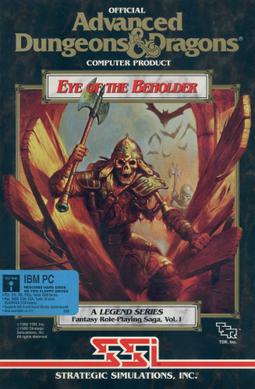
Eye of the Beholder is a role-playing video game for personal computers and video game consoles developed by Westwood Associates. It was published by Strategic Simulations, Inc. in 1991, for the MS-DOS operating system and later ported to the Amiga, the Sega CD and the SNES. The Sega CD version features a soundtrack composed by Yuzo Koshiro and Motohiro Kawashima. A port to the Atari Lynx handheld was developed by NuFX in 1993, but was not released. In 2002, an adaptation of the same name was developed by Pronto Games for the Game Boy Advance.

Curse of the Azure Bonds is a role-playing video game developed and published by Strategic Simulations, Inc (SSI) in 1989. It is the second in a four-part series of Forgotten Realms Advanced Dungeons & Dragons Gold Box adventure computer games, continuing the events after the first part, Pool of Radiance.

Gold Box is a series of role-playing video games produced by SSI from 1988 to 1992. The company acquired a license to produce games based on the Advanced Dungeons & Dragons role-playing game from TSR, Inc. These games shared a common game engine that came to be known as the "Gold Box Engine" after the gold-colored boxes in which most games of the series were sold.
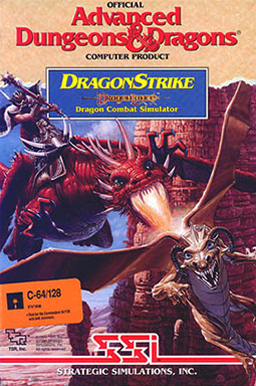
DragonStrike is a 1990 video game based on the Dungeons & Dragons fantasy tabletop role-playing game.

Pools of Darkness is a role-playing video game published by Strategic Simulations in 1991. The cover art and introduction screen shows a female drow. It is the fourth entry in the Pool of Radiance series of Gold Box games, and the story is a continuation of the events after Secret of the Silver Blades. The novel loosely based on the game was released in 1992. Like the previous games in the series, it is set in the Forgotten Realms, a campaign setting from Dungeons & Dragons. Players must stop an invasion from an evil god, eventually traveling to other dimensions to confront his lieutenants.
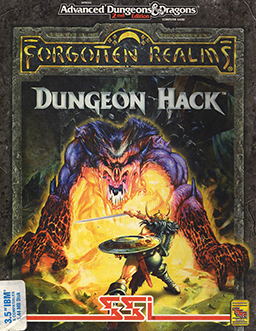
Dungeon Hack is a 1993 role-playing video game developed by DreamForge Intertainment and published by Strategic Simulations for DOS and NEC PC-9801.

Secret of the Silver Blades is the third in a four-part series of Forgotten Realms Dungeons & Dragons "Gold Box" adventure role-playing video games. The game was released in 1990.
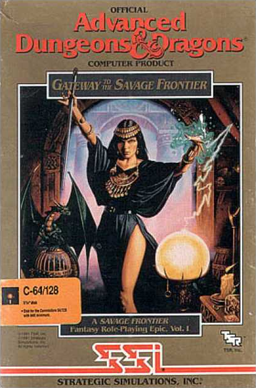
Gateway to the Savage Frontier (1991) is a Gold BoxDungeons and Dragons computer game developed by Beyond Software and published by SSI for the Commodore 64, PC and Amiga personal computers.
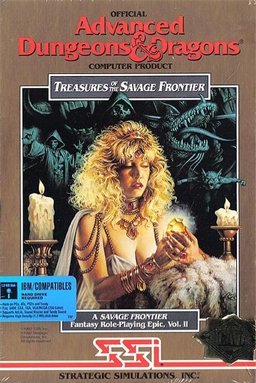
Treasures of the Savage Frontier (1992) is a Gold Box Dungeons and Dragons role-playing video game. It was developed by Beyond Software and published by SSI for the Amiga and DOS.
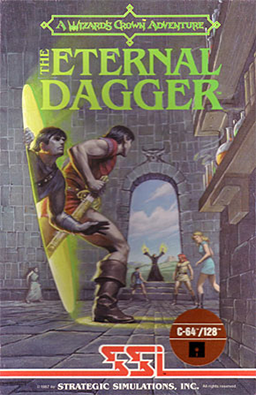
The Eternal Dagger is a top-down role-playing video game published by Strategic Simulations in 1987. It is a sequel to Wizard's Crown from 1986. Demons from another dimension are invading the world, and the only item that can seal the portal is the titular dagger. Players can transfer their characters over from Wizard's Crown, minus whatever magical items they had on them.

Champions of Krynn is role-playing video game, the first in a three-part series of Dragonlance Advanced Dungeons & Dragons "Gold Box" games. The game was released in 1990. The highest graphics setting supported in the DOS version was EGA graphics. It also supported the Adlib sound card and either a mouse or joystick.

Death Knights of Krynn is the second in a three-part series of Dragonlance Advanced Dungeons & Dragons "Gold Box" role-playing video games, published by Strategic Simulations. The game was released in 1991.

Eye of the Beholder II: The Legend of Darkmoon is a 1991 role-playing video game and the sequel to the first Eye of the Beholder. It used a modified version of the first game's engine, added outdoor areas and greatly increased the amount of interaction the player had with their environment, along with substantially more role-playing aspects to the game. A sequel, Eye of the Beholder III: Assault on Myth Drannor, was released in 1993.

Dark Sun: Wake of the Ravager is a role-playing video game developed and published by Strategic Simulations in 1994 for the MS-DOS operating system. It is the sequel to Dark Sun: Shattered Lands.

Al-Qadim: The Genie's Curse is an action role-playing game for the personal computer set in the Al-Qadim campaign setting of Advanced Dungeons and Dragons. The game was developed by Cyberlore Studios and published in 1994 by Strategic Simulations (SSI). The game combines role-playing game and adventure with a simplified interface; the player's character is a young corsair trying to clear his family's name, rescue his betrothed and determine who has been freeing genies from their masters.
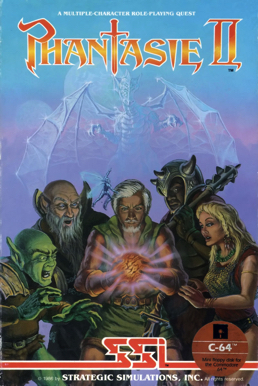
Phantasie II is the second game in the Phantasie series of role-playing video games.

Prophecy of the Shadow is a 1992 fantasy role-playing video game developed by Strategic Simulations for MS-DOS. The game was released in both English and German versions.

Ravenloft: Stone Prophet is a fantasy role-playing video game developed by DreamForge Intertainment for MS-DOS and published by Strategic Simulations in 1995.
Pool of Radiance is a series of role-playing video games set in the Forgotten Realms campaign settings of Dungeons & Dragons; it was the first Dungeons & Dragons video game series to be based on the Advanced Dungeons & Dragons rules.



















